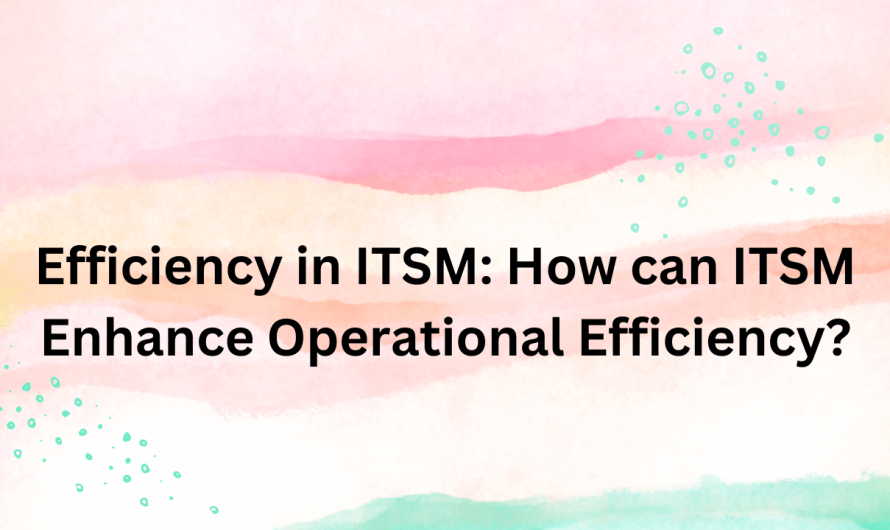In the fast-paced digital landscape, organizations are constantly seeking ways to optimize their operations. One powerful tool in this pursuit is IT Service Management (ITSM). But what exactly is ITSM, and how can it significantly enhance operational efficiency? In this article, we’ll explore the ins and outs of ITSM in a language that everyone can understand, steering clear of technical jargon and complexity.
Introduction to IT Service Management
IT Service Management, or ITSM, is a set of practices aimed at aligning IT services with the needs of the business. Think of it as the conductor of an orchestra, ensuring that every instrument (or department) plays in harmony to produce a beautiful symphony of productivity.
Understanding Operational Efficiency
Operational efficiency is the key to organizational success. It involves optimizing processes to reduce waste, save time, and enhance overall productivity. In the world of IT, this means ensuring that every digital cog in the machine works seamlessly.
The Role of ITSM in Streamlining Processes
Enter ITSM, the superhero of streamlined processes. It acts as a guide, helping organizations map out and improve their workflows, making sure that each step is as efficient as possible.
Benefits of ITSM Implementation
Implementing ITSM brings a plethora of benefits. From increased productivity to improved service delivery, organizations stand to gain significantly by embracing this approach.
User-Friendly Interfaces and ITSM
One of the jewels in ITSM’s crown is its emphasis on user-friendly interfaces. Just like a smartphone with an intuitive design, ITSM ensures that employees can navigate systems and processes with ease.
Proactive Problem Solving with ITSM
Instead of waiting for problems to arise, ITSM takes a proactive stance. It anticipates issues, addresses them before they become significant, and keeps the organizational engine running smoothly.
Cost-Efficiency Through ITSM Practices
Money matters, and ITSM understands that. By optimizing processes and preventing issues, it contributes to significant cost savings, allowing organizations to invest in areas that truly matter.
Enhancing Collaboration with ITSM
Collaboration is the heartbeat of any successful organization. ITSM acts as a facilitator, ensuring that different departments work cohesively towards common goals.
Security Measures in IT Service Management
In the digital realm, security is non-negotiable. ITSM incorporates robust security measures, safeguarding sensitive information and protecting organizations from cyber threats.
Scalability: Adapting to Growing Needs
As organizations grow, so do their needs. ITSM is designed to scale, accommodating increased demands and ensuring that efficiency is maintained even in times of expansion.
Measuring Success: Metrics in ITSM
To know if something is working, you need metrics. ITSM provides measurable data, allowing organizations to gauge the success of their operations and make informed decisions.
Challenges in Implementing ITSM
While the benefits are immense, implementing ITSM comes with its set of challenges. From resistance to change to the complexity of integration, organizations need to navigate these hurdles strategically.
Real-Life Analogies: ITSM Simplified
Think of ITSM as the traffic lights on a busy intersection. It regulates the flow of information, preventing chaos and ensuring that everything moves smoothly.
Case Studies: Successful ITSM Implementations
Real-world examples speak louder than theories. Explore how organizations across industries have leveraged ITSM to revolutionize their operations.
Looking to the Future: ITSM Trends
What does the future hold for ITSM? Explore emerging trends that promise to take operational efficiency to new heights.
FAQs
Q1: Can ITSM be implemented in small businesses?
Yes, ITSM principles are scalable and can be adapted to suit the needs of small businesses, enhancing their operational efficiency.
Q2: How long does it take to see results after implementing ITSM?
The timeline varies, but many organizations experience noticeable improvements in operational efficiency within a few months of adopting ITSM practices.
Q3: Is ITSM only relevant to the IT department?
While rooted in IT, the principles of ITSM can be applied across various departments, benefiting the organization as a whole.
Q4: Are there open-source ITSM solutions available?
Yes, there are open-source ITSM solutions, providing cost-effective options for organizations looking to implement ITSM practices.
Q5: Can ITSM improve customer satisfaction?
Absolutely. By streamlining processes and resolving issues proactively, ITSM contributes to a smoother customer experience, leading to increased satisfaction.



